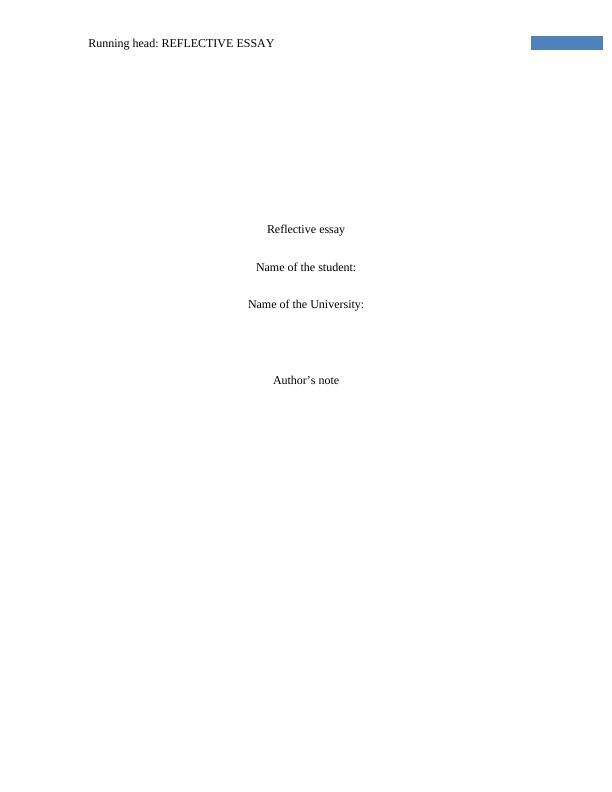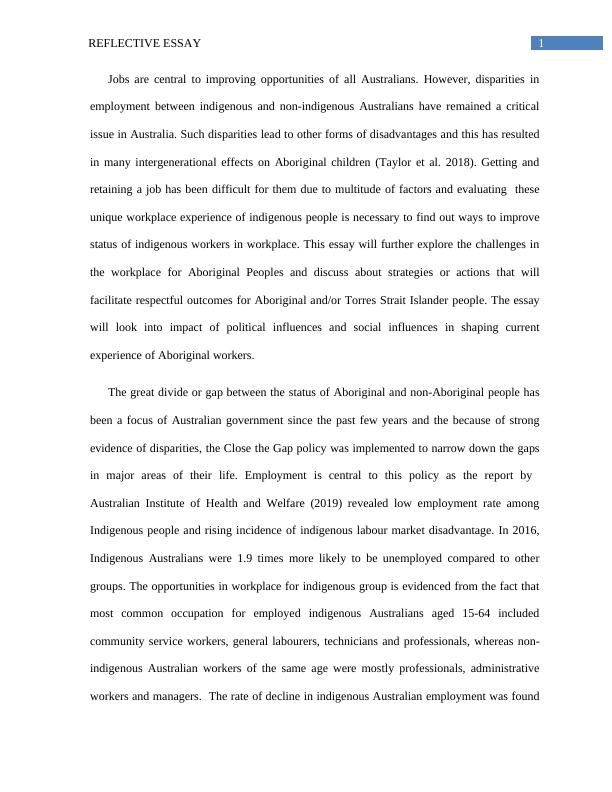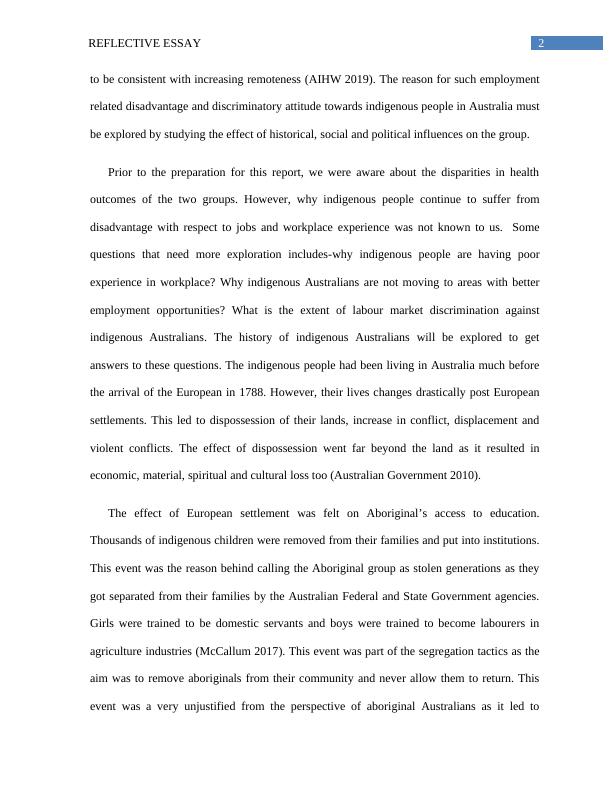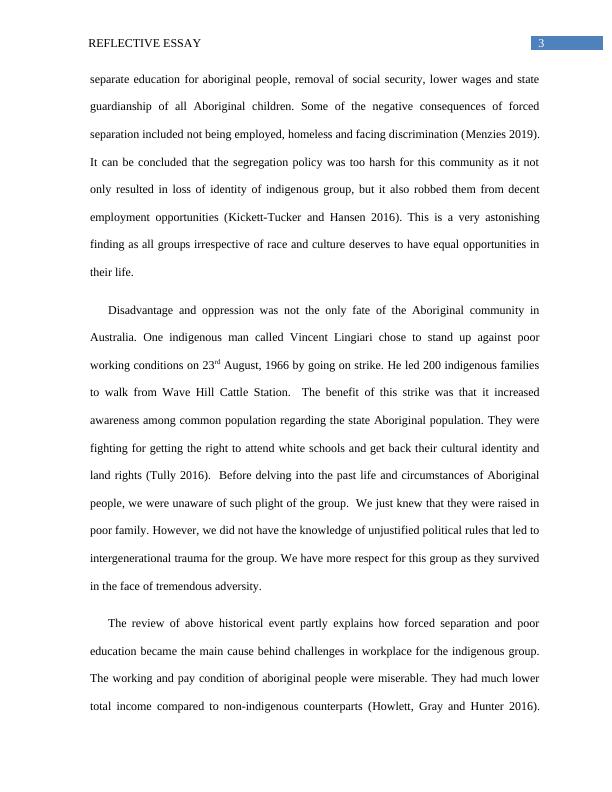Challenges in the Workplace for Aboriginal Peoples: Strategies for Respectful Outcomes
Added on 2022-08-10
11 Pages2796 Words86 Views
Running head: REFLECTIVE ESSAY
Reflective essay
Name of the student:
Name of the University:
Author’s note
Reflective essay
Name of the student:
Name of the University:
Author’s note

1REFLECTIVE ESSAY
Jobs are central to improving opportunities of all Australians. However, disparities in
employment between indigenous and non-indigenous Australians have remained a critical
issue in Australia. Such disparities lead to other forms of disadvantages and this has resulted
in many intergenerational effects on Aboriginal children (Taylor et al. 2018). Getting and
retaining a job has been difficult for them due to multitude of factors and evaluating these
unique workplace experience of indigenous people is necessary to find out ways to improve
status of indigenous workers in workplace. This essay will further explore the challenges in
the workplace for Aboriginal Peoples and discuss about strategies or actions that will
facilitate respectful outcomes for Aboriginal and/or Torres Strait Islander people. The essay
will look into impact of political influences and social influences in shaping current
experience of Aboriginal workers.
The great divide or gap between the status of Aboriginal and non-Aboriginal people has
been a focus of Australian government since the past few years and the because of strong
evidence of disparities, the Close the Gap policy was implemented to narrow down the gaps
in major areas of their life. Employment is central to this policy as the report by
Australian Institute of Health and Welfare (2019) revealed low employment rate among
Indigenous people and rising incidence of indigenous labour market disadvantage. In 2016,
Indigenous Australians were 1.9 times more likely to be unemployed compared to other
groups. The opportunities in workplace for indigenous group is evidenced from the fact that
most common occupation for employed indigenous Australians aged 15-64 included
community service workers, general labourers, technicians and professionals, whereas non-
indigenous Australian workers of the same age were mostly professionals, administrative
workers and managers. The rate of decline in indigenous Australian employment was found
Jobs are central to improving opportunities of all Australians. However, disparities in
employment between indigenous and non-indigenous Australians have remained a critical
issue in Australia. Such disparities lead to other forms of disadvantages and this has resulted
in many intergenerational effects on Aboriginal children (Taylor et al. 2018). Getting and
retaining a job has been difficult for them due to multitude of factors and evaluating these
unique workplace experience of indigenous people is necessary to find out ways to improve
status of indigenous workers in workplace. This essay will further explore the challenges in
the workplace for Aboriginal Peoples and discuss about strategies or actions that will
facilitate respectful outcomes for Aboriginal and/or Torres Strait Islander people. The essay
will look into impact of political influences and social influences in shaping current
experience of Aboriginal workers.
The great divide or gap between the status of Aboriginal and non-Aboriginal people has
been a focus of Australian government since the past few years and the because of strong
evidence of disparities, the Close the Gap policy was implemented to narrow down the gaps
in major areas of their life. Employment is central to this policy as the report by
Australian Institute of Health and Welfare (2019) revealed low employment rate among
Indigenous people and rising incidence of indigenous labour market disadvantage. In 2016,
Indigenous Australians were 1.9 times more likely to be unemployed compared to other
groups. The opportunities in workplace for indigenous group is evidenced from the fact that
most common occupation for employed indigenous Australians aged 15-64 included
community service workers, general labourers, technicians and professionals, whereas non-
indigenous Australian workers of the same age were mostly professionals, administrative
workers and managers. The rate of decline in indigenous Australian employment was found

2REFLECTIVE ESSAY
to be consistent with increasing remoteness (AIHW 2019). The reason for such employment
related disadvantage and discriminatory attitude towards indigenous people in Australia must
be explored by studying the effect of historical, social and political influences on the group.
Prior to the preparation for this report, we were aware about the disparities in health
outcomes of the two groups. However, why indigenous people continue to suffer from
disadvantage with respect to jobs and workplace experience was not known to us. Some
questions that need more exploration includes-why indigenous people are having poor
experience in workplace? Why indigenous Australians are not moving to areas with better
employment opportunities? What is the extent of labour market discrimination against
indigenous Australians. The history of indigenous Australians will be explored to get
answers to these questions. The indigenous people had been living in Australia much before
the arrival of the European in 1788. However, their lives changes drastically post European
settlements. This led to dispossession of their lands, increase in conflict, displacement and
violent conflicts. The effect of dispossession went far beyond the land as it resulted in
economic, material, spiritual and cultural loss too (Australian Government 2010).
The effect of European settlement was felt on Aboriginal’s access to education.
Thousands of indigenous children were removed from their families and put into institutions.
This event was the reason behind calling the Aboriginal group as stolen generations as they
got separated from their families by the Australian Federal and State Government agencies.
Girls were trained to be domestic servants and boys were trained to become labourers in
agriculture industries (McCallum 2017). This event was part of the segregation tactics as the
aim was to remove aboriginals from their community and never allow them to return. This
event was a very unjustified from the perspective of aboriginal Australians as it led to
to be consistent with increasing remoteness (AIHW 2019). The reason for such employment
related disadvantage and discriminatory attitude towards indigenous people in Australia must
be explored by studying the effect of historical, social and political influences on the group.
Prior to the preparation for this report, we were aware about the disparities in health
outcomes of the two groups. However, why indigenous people continue to suffer from
disadvantage with respect to jobs and workplace experience was not known to us. Some
questions that need more exploration includes-why indigenous people are having poor
experience in workplace? Why indigenous Australians are not moving to areas with better
employment opportunities? What is the extent of labour market discrimination against
indigenous Australians. The history of indigenous Australians will be explored to get
answers to these questions. The indigenous people had been living in Australia much before
the arrival of the European in 1788. However, their lives changes drastically post European
settlements. This led to dispossession of their lands, increase in conflict, displacement and
violent conflicts. The effect of dispossession went far beyond the land as it resulted in
economic, material, spiritual and cultural loss too (Australian Government 2010).
The effect of European settlement was felt on Aboriginal’s access to education.
Thousands of indigenous children were removed from their families and put into institutions.
This event was the reason behind calling the Aboriginal group as stolen generations as they
got separated from their families by the Australian Federal and State Government agencies.
Girls were trained to be domestic servants and boys were trained to become labourers in
agriculture industries (McCallum 2017). This event was part of the segregation tactics as the
aim was to remove aboriginals from their community and never allow them to return. This
event was a very unjustified from the perspective of aboriginal Australians as it led to

3REFLECTIVE ESSAY
separate education for aboriginal people, removal of social security, lower wages and state
guardianship of all Aboriginal children. Some of the negative consequences of forced
separation included not being employed, homeless and facing discrimination (Menzies 2019).
It can be concluded that the segregation policy was too harsh for this community as it not
only resulted in loss of identity of indigenous group, but it also robbed them from decent
employment opportunities (Kickett-Tucker and Hansen 2016). This is a very astonishing
finding as all groups irrespective of race and culture deserves to have equal opportunities in
their life.
Disadvantage and oppression was not the only fate of the Aboriginal community in
Australia. One indigenous man called Vincent Lingiari chose to stand up against poor
working conditions on 23rd August, 1966 by going on strike. He led 200 indigenous families
to walk from Wave Hill Cattle Station. The benefit of this strike was that it increased
awareness among common population regarding the state Aboriginal population. They were
fighting for getting the right to attend white schools and get back their cultural identity and
land rights (Tully 2016). Before delving into the past life and circumstances of Aboriginal
people, we were unaware of such plight of the group. We just knew that they were raised in
poor family. However, we did not have the knowledge of unjustified political rules that led to
intergenerational trauma for the group. We have more respect for this group as they survived
in the face of tremendous adversity.
The review of above historical event partly explains how forced separation and poor
education became the main cause behind challenges in workplace for the indigenous group.
The working and pay condition of aboriginal people were miserable. They had much lower
total income compared to non-indigenous counterparts (Howlett, Gray and Hunter 2016).
separate education for aboriginal people, removal of social security, lower wages and state
guardianship of all Aboriginal children. Some of the negative consequences of forced
separation included not being employed, homeless and facing discrimination (Menzies 2019).
It can be concluded that the segregation policy was too harsh for this community as it not
only resulted in loss of identity of indigenous group, but it also robbed them from decent
employment opportunities (Kickett-Tucker and Hansen 2016). This is a very astonishing
finding as all groups irrespective of race and culture deserves to have equal opportunities in
their life.
Disadvantage and oppression was not the only fate of the Aboriginal community in
Australia. One indigenous man called Vincent Lingiari chose to stand up against poor
working conditions on 23rd August, 1966 by going on strike. He led 200 indigenous families
to walk from Wave Hill Cattle Station. The benefit of this strike was that it increased
awareness among common population regarding the state Aboriginal population. They were
fighting for getting the right to attend white schools and get back their cultural identity and
land rights (Tully 2016). Before delving into the past life and circumstances of Aboriginal
people, we were unaware of such plight of the group. We just knew that they were raised in
poor family. However, we did not have the knowledge of unjustified political rules that led to
intergenerational trauma for the group. We have more respect for this group as they survived
in the face of tremendous adversity.
The review of above historical event partly explains how forced separation and poor
education became the main cause behind challenges in workplace for the indigenous group.
The working and pay condition of aboriginal people were miserable. They had much lower
total income compared to non-indigenous counterparts (Howlett, Gray and Hunter 2016).

End of preview
Want to access all the pages? Upload your documents or become a member.
Related Documents
Indigenous Australians Essaylg...
|12
|3185
|270
Well-being and Prevention in Health - Doclg...
|10
|2354
|92
Deconstructing the Question: Why Don't Aboriginals Take an Interest in Health and Well-being?lg...
|9
|2213
|224
Deconstructing the Question: Why are not Aborigines Interested in Being Successful?lg...
|7
|1834
|281
Essay on Rights of Indigenous Australialg...
|8
|1624
|47
Australian Healthcare System: Historical and Political Influences and RN Role in Nursinglg...
|10
|2476
|374
